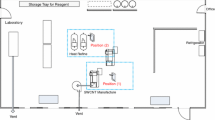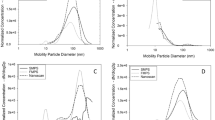Abstract
Workplace exposure to nanoparticles from gas metal arc welding (GMAW) process in an automobile manufacturing factory was investigated using a combination of multiple metrics and a comparison with background particles. The number concentration (NC), lung-deposited surface area concentration (SAC), estimated SAC and mass concentration (MC) of nanoparticles produced from the GMAW process were significantly higher than those of background particles before welding (P < 0.01). A bimodal size distribution by mass for welding particles with two peak values (i.e., 10,000–18,000 and 560–320 nm) and a unimodal size distribution by number with 190.7-nm mode size or 154.9-nm geometric size were observed. Nanoparticles by number comprised 60.7 % of particles, whereas nanoparticles by mass only accounted for 18.2 % of the total particles. The morphology of welding particles was dominated by the formation of chain-like agglomerates of primary particles. The metal composition of these welding particles consisted primarily of Fe, Mn, and Zn. The size distribution, morphology, and elemental compositions of welding particles were significantly different from background particles. Working activities, sampling distances from the source, air velocity, engineering control measures, and background particles in working places had significant influences on concentrations of airborne nanoparticle. In addition, SAC showed a high correlation with NC and a relatively low correlation with MC. These findings indicate that the GMAW process is able to generate significant levels of nanoparticles. It is recommended that a combination of multiple metrics is measured as part of a well-designed sampling strategy for airborne nanoparticles. Key exposure factors, such as particle agglomeration/aggregation, background particles, working activities, temporal and spatial distributions of the particles, air velocity, engineering control measures, should be investigated when measuring workplace exposure to nanoparticles.





Similar content being viewed by others
References
Antonini JM (2003) Health effects of welding. Crit Rev Toxicol 33(1):61–103
Banfield JF, Navrotsky A (2001) Nanoparticles and the environment. Mineralogical Society of America, Washington, DC
IUTA, BAuA, BG RCI, IFA, TUD, VCI (2011) Tiered approach to an exposure measurement and assessment of nanoscale aerosols released from engineered nanomaterials in workplace operations. In: Air quality and sustainable nanotechnology, p 1–26
Brouwer D (2010) Exposure to manufactured nanoparticles in different workplaces. Toxicology 269(2–3):120–127
Brouwer DH, Gijsbers JH, Lurvink MW (2004) Personal exposure to ultrafine particles in the workplace: exploring sampling techniques and strategies. Ann Occup Hyg 48(5):439–453
Charron A, Harrison RM (2003) Particle formation from vehicle emissions during exhaust dilution in the roadside atmosphere. Atmos Environ 37(29):4109–4119
Cheng YH, Chao YC, Wu CH, Tsai CJ, Uang SN, Shih TS (2008) Measurements of ultrafine particle concentrations and size distribution in an iron foundry. J Hazard Mater 158(1):124–130
Dasch J, D’Arcy J (2008) Physical and chemical characterization of airborne particles from welding operations in automotive plants. J Occup Environ Hyg 5(7):444–454
Dasch J, D’Arcy J, Gundrum A, Sutherland J, Johnson J, Carlson D (2005) Characterization of fine particles from machining in automotive plants. J Occup Environ Hyg 2(12):609–625
Demou E, Peter P, Hellweg S (2008) Exposure to manufactured nanostructured particles in an industrial pilot plant. Ann Occup Hyg 52(8):695–706
Elihn K, Berg P (2009) Ultrafine particle characteristics in seven industrial plants. Ann Occup Hyg 53(5):475–484
Fuglsang K, Gram LK, Markussen JB, Kristensen JK (2011) Measurement of ultrafine particles in emissions from welding processes. In: 6th International conference on joining of materials, elsinore, 10–13 May 2011
Gomes JF, Albuquerque PC, Miranda RM, Santos TG, Vieira MT (2012) Comparison of deposited surface area of airborne ultrafine particles generated from two welding processes. Inhal Toxicol 24(11):774–781. doi:10.3109/08958378.2012.717
Heitbrink WA, Evans DE, Ku BK, Maynard AD, Slavin TJ, Peters TM (2009) Relationships among particle number, surface area, and respirable mass concentrations in automotive engine manufacturing. J Occup Environ Hyg 6(1):19–31
Hewett P (1995) The particle size distribution, density, and specific surface area of welding fumes from SMAW and GMAW mild and stainless steel consumables. Am Ind Hyg Assoc J 56(2):128–135
Hovde CA, Raynor PC (2007) Effects of voltage and wire feed speed on weld fume characteristics. J Occup Environ Hyg 4(12):903–912
Hussein T, KarPPinen A, Kukkonen J (2006) Meteorological dependence of size fractionated number concentrations of urban aerosol particles. Atmos Environ 40(8):1427–1440
ISO (1997) Road vehicles—test dust for filter evaluation—Part 1: Arizona test dust. ISO 12103-1-1997
Jenkins NT, Pierce WMG, Eagar TW (2005) Particle size distribution of gas metal and flux cored arc welding fumes. Weld Res 84(10):156–163
Johnson DR, Methner MM, Kennedy AJ, Steevens JA (2010) Potential for occupational exposure to engineered carbon-based nanomaterials in environmental laboratory studies. Environ Health Perspect 118(1):49–54. doi:10.1289/ehp.0901076
Khlystov A, Stanier C, Pandis SN (2004) An algorithm for combining electrical mobility and aerodynamic size distributions data when measuring ambient aerosol. Aerosol Sci Technol 38(1):229–238
Kuhlbusch T, Asbach C, Fissan H, Göhler D, Stintz M (2011) Nanoparticle exposure at nanotechnology workplaces: a review. Part Fibre Toxicol 8(22):1–18
La Vecchia GM, Maestrelli P (2011) New welding processes and health effects of welding. G Ital Med Lav Ergon 33(3):252–256
Lee M, McClellan WJ, Candela J, Andrews D, Biswas P (2007) Reduction of nanoparticle exposure to welding aerosols by modification of the ventilation system in a workplace. J Nanopart Res 9(1):127–136
Lepeule J, Laden F, Dockery D, Schwartz J (2012) Chronic exposure to fine particles and mortality: an extended follow-up of the Harvard Six Cities study from 1974 to 2009. Environ Health Perspect 120(7):965–970
Maynard AD, Aitken RJ (2007) Assessing exposure to airborne nanomaterials: current abilities and future requirements. Nanotoxicology 1(1):26–41
Methner MM (2008) Engineering case reports. Effectiveness of local exhaust ventilation (LEV) in controlling engineered nanomaterial emissions during reactor cleanout operations. J Occup Environ Hyg 5(6):63–69
Methner M, Hodson L, Dames A, Geraci C (2010) Nanoparticle Emission Assessment Technique (NEAT) for the identification and measurement of potential inhalation exposure to engineered nanomaterials–Part B: results from 12 field studies. J Occup Environ Hyg 7(3):163–176
Methner M, Beaucham C, Crawford C, Hodson L, Geraci C (2012) Field application of the Nanoparticle Emission Assessment Technique (NEAT): task-based air monitoring during the processing of engineered nanomaterials (ENM) at four facilities. J Occup Environ Hyg 9(9):543–555
Morawska L, Wang H, Ristovski Z, Jayaratne ER, Johnson G, Cheung HC, Ling X, He C (2009) JEM spotlight: environmental monitoring of airborne nanoparticles. J Environ Monit 11(10):1758–1773
NIOSH (2009) Approaches to safe nanotechnology: managing the health and safety concerns with engineered nanomaterials. DHHS (NIOSH) Publication No. 2009-125
Oberdörster G (2000) Toxicology of ultrafine particles: in vivo studies. Phil Trans R Soc Lond A 358(1775):2719–2740
OECD (2009) Emission assessment for identification of sources and release of airborne manufactured nanomaterials in the workplace: compilation of existing guidance. OECD working party for manufactured nanomaterials (WPMN) No. 11 ENV/JM/MONO(2009) 16
Ono-Ogasawara M, Serita F, Takaya M (2009) Distinguishing nanomaterial particles from background airborne particulate matter for quantitative exposure assessment. J Nanopart Res 11:1651–1659
Peters MT, Heitbrink WA, Evans DE, Slavin TJ, Maynard AD (2006) The mapping of fine and ultrafine particle concentrations in an engine machining and assembly facility. Ann Occup Hyg 50(3):249–257
Ramachandran G, Paulsen D, Watts W, Kittelson D (2005) Mass, surface area and number metrics in diesel occupational exposure assessment. J Environ Monit 7(7):728–735
Son JY, Lee JT, Kim KH, Jung K, Bell ML (2012) Characterization of fine particulate matter and associations between particulate chemical constituents and mortality in Seoul Korea. Environ Health Perspect 120(6):872–878. doi:10.1289/ehp.1104316
Stephenson D, Seshadri G, Veranth JM (2003) Workplace exposure to submicron particle mass and number concentrations from manual arc welding of carbon steel. AIHA J 64(4):516–521
Stoeger T, Reinhard C, Takenaka S, Schroeppel A, Karg E, Ritter B (2006) Instillation of six different ultrafine carbon particles indicates a surface area threshold dose for acute lung inflammation in mice. Environ Health Perspect 114(3):328–333
Tran CL, Buchanan D, Cullen RT, Searl A, Jones AD, Donaldson K (2000) Inhalation of poorly soluble particles. II. Influence of particle surface area on inflammation and clearance. Inhal Toxicol 12(12):1113–1126
Zimmer AT, Biswas P (2001) Characterization aerosols resulting from arc welding processes. J Aerosol Sci 32:993–1008
Acknowledgments
This research work was supported by the Health Standards Fund of Ministry of Health of China (20130215), National Nature Science Funds of China (No. 81001242), and Science and Technology Fund from Health Bureau of Zhejiang Province (No. 2012KYB050). We are grateful to Professor Miller Greg (Griffith University, Australia) for his suggestions throughout this study.
Author information
Authors and Affiliations
Corresponding author
Rights and permissions
About this article
Cite this article
Zhang, M., Jian, L., Bin, P. et al. Workplace exposure to nanoparticles from gas metal arc welding process. J Nanopart Res 15, 2016 (2013). https://doi.org/10.1007/s11051-013-2016-4
Received:
Accepted:
Published:
DOI: https://doi.org/10.1007/s11051-013-2016-4




